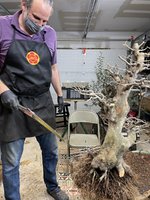Makes perfect sense to me. I chopped back to a new leader so wasn't to worried about that on the spring chop. The winter chop was chopped hoping for a new leader. Was caught up between chopping it in winter or spring, so I just couldn't resist. Now Im glad I chopped the first one in winter. Thank you.
Good info! Thanks
As trees like maples break dormancy, they bring into play almost all of their stored energy to power new foliage growth and distribute it to the buds most likely to strengthen the tree by growing well, ie., the buds at the ends of branches and higher up in the canopy. When you chopped your tree mid winter, there was still a fair amount of stored carbs in the trunk and roots that could be utilized by dormant buds near the chop site. By chopping the second tree after buds have pushed and also repotting at the same time, there was little energy in reserve to help push dormant buds into active growth. I've personally cut back large branches on my trees, knowing there were dormant buds present closer to the trunk, after the buds have pushed, only to lose the entire branch as no new buds popped. Your best plan now is to seal the chop if you haven't already, fertilize well and hope a bud or two breaks before the trunk dies back from the chop.
So essentially the sap and energy are all flowing and being pushed out to the buds at the moment, resulting in them opening.
Quite literally, if branches are cut now, that energy will be wasted, correct?
Sounds like you are a good source of info on maples! I didn’t know @Dav4


